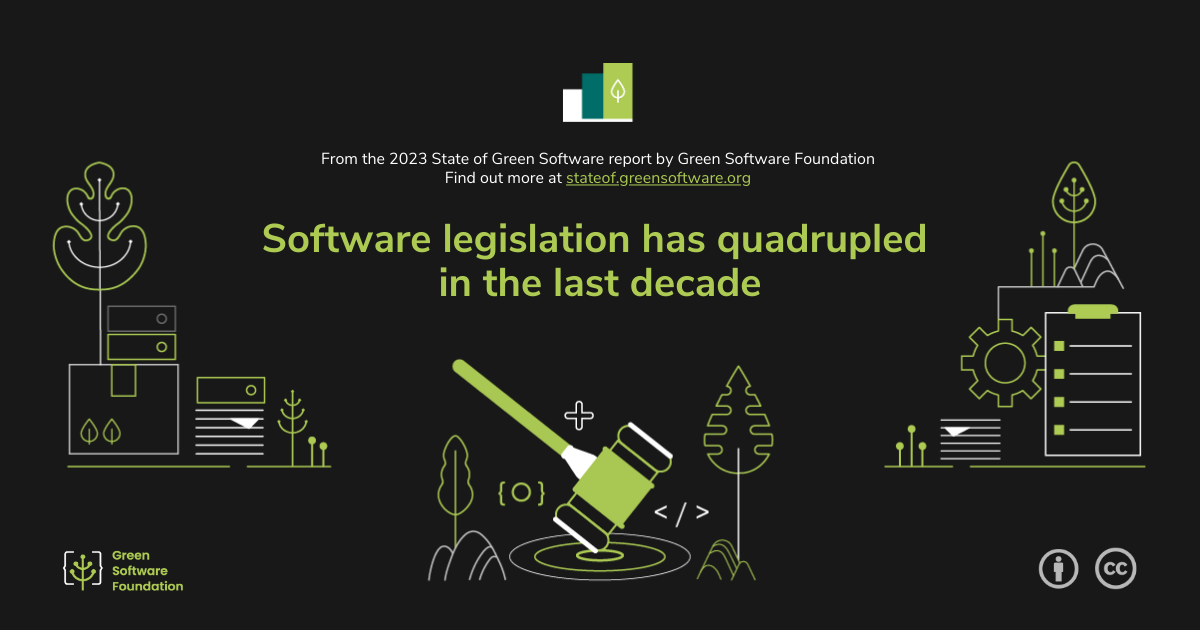Software legislation has quadrupled in the last decade
The prevalence of software-focused legislation has quadrupled in the last decade, with 40% of countries having introduced some form of regulation by 2021. Of these countries, which comprise those in Europe, Africa, Asia, and the Pacific, nearly a third include specific provisions for environmental regulations.
And this trend only looks set to increase. At the 2022 World Telecommunication Development Conference, 127 national governments agreed to the United Nations Security Council Resolution 66, committing “to incorporate environmental indicators, conditions and standards in their national ICT plans.” Research shows that environmental regulation is beneficial for green business productivity and innovation. As such, more sustainability regulation is likely to stimulate a significant expansion in green software innovation and adoption.
Europe, in particular, is leading the regulatory agenda; looking to influence the global regulatory landscape for digital emissions in the same way it did for data privacy. The European Commission (EU) has stated that Europe “will update existing laws and introduce new measures to achieve our green and digital goals for the next decade…the EU is also exploring voluntary and binding measures to help the private sector become climate neutral and use more renewable resources.” In the European Parliament, the Green Party has made digital emissions regulation a key part of their agenda, while the EU’s foreign policy agency, the EU Institute for Security Studies (EUISS), has called for a regulatory expansion in the green digitalization arena with the explicit goal of influencing global standards.
France has started to roll out its own green software legislation. The Réduire l’Empreinte Environnementale du Numérique (Digital Environmental Footprint Reduction) legislation comes into force in 2023-2024 and includes mandatory digital emissions disclosures, green software curricula, the prevention of software-driven hardware obsolescence, and a statutory duty for all municipalities with over 50,000 inhabitants to develop their own local green software strategies. This reflects a steadily expanding green software regulatory landscape in France.
But this trend exists beyond Europe. In the United States, the Securities and Exchange Commission is proposing rules “to require registrants to provide certain climate-related information in their registration statements and annual reports, including certain information about climate-related financial risks and climate-related financial metrics in their financial statements.” These will likely include scopes 2 and 3 digital emissions disclosures. The nature of the final disclosures is yet to be determined. It may not be as strong as initially hoped in the face of some industry resistance, but the direction of travel is unmistakable. Similarly, President Biden’s Executive Order 14067 on Responsible Digital Assets commits the United States to “ensuring that digital asset technologies and the digital payments ecosystem are developed, designed, and implemented in a responsible manner that …reduces negative climate impacts and environmental pollution.”
Progress is also underway in China, where the environmental protection target responsibility system now links energy conservation and emission reduction targets to the performance assessment of government officials.
This trend toward regulatory action targeting digital emissions can be seen at the general level and in major industry niches. In the AI space, the OECD advocates for “widely used or mandatory reporting requirements” on the environmental impacts of machine learning, explicitly calling for “regulations, standards, and policies (including tax policies).” The blockchain sector has also seen regulations introduced with US Executive Order 14067, which commits to environmentally responsible blockchain, and mandates rapid preparatory work to establish “the connections between distributed ledger technology and short-, medium-, and long-term economic and energy transitions.”
Given these developments, green software is expected to become increasingly prevalent in global legislative, regulatory, and reporting domains over the next decade.
